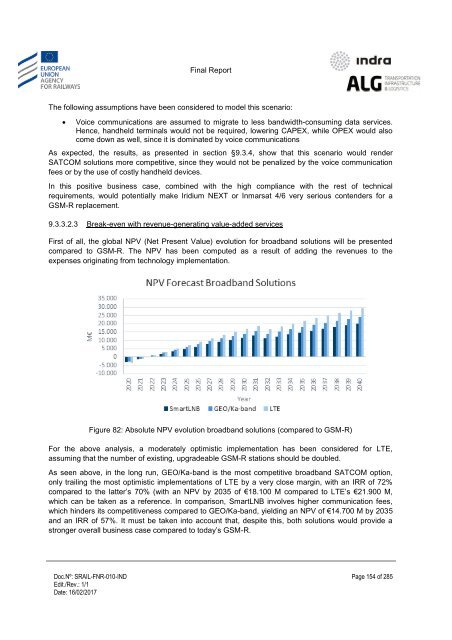Study on feasibility of SATCOM for railway communication
SRAIL-FNR-010-IND%20-%20FinalReport_v1.1_20170216
SRAIL-FNR-010-IND%20-%20FinalReport_v1.1_20170216
Create successful ePaper yourself
Turn your PDF publications into a flip-book with our unique Google optimized e-Paper software.
Final Report<br />
The following assumpti<strong>on</strong>s have been c<strong>on</strong>sidered to model this scenario:<br />
<br />
Voice communicati<strong>on</strong>s are assumed to migrate to less bandwidth-c<strong>on</strong>suming data services.<br />
Hence, handheld terminals would not be required, lowering CAPEX, while OPEX would also<br />
come down as well, since it is dominated by voice communicati<strong>on</strong>s<br />
As expected, the results, as presented in secti<strong>on</strong> §9.3.4, show that this scenario would render<br />
<strong>SATCOM</strong> soluti<strong>on</strong>s more competitive, since they would not be penalized by the voice communicati<strong>on</strong><br />
fees or by the use <strong>of</strong> costly handheld devices.<br />
In this positive business case, combined with the high compliance with the rest <strong>of</strong> technical<br />
requirements, would potentially make Iridium NEXT or Inmarsat 4/6 very serious c<strong>on</strong>tenders <strong>for</strong> a<br />
GSM-R replacement.<br />
9.3.3.2.3 Break-even with revenue-generating value-added services<br />
First <strong>of</strong> all, the global NPV (Net Present Value) evoluti<strong>on</strong> <strong>for</strong> broadband soluti<strong>on</strong>s will be presented<br />
compared to GSM-R. The NPV has been computed as a result <strong>of</strong> adding the revenues to the<br />
expenses originating from technology implementati<strong>on</strong>.<br />
Figure 82: Absolute NPV evoluti<strong>on</strong> broadband soluti<strong>on</strong>s (compared to GSM-R)<br />
For the above analysis, a moderately optimistic implementati<strong>on</strong> has been c<strong>on</strong>sidered <strong>for</strong> LTE,<br />
assuming that the number <strong>of</strong> existing, upgradeable GSM-R stati<strong>on</strong>s should be doubled.<br />
As seen above, in the l<strong>on</strong>g run, GEO/Ka-band is the most competitive broadband <strong>SATCOM</strong> opti<strong>on</strong>,<br />
<strong>on</strong>ly trailing the most optimistic implementati<strong>on</strong>s <strong>of</strong> LTE by a very close margin, with an IRR <strong>of</strong> 72%<br />
compared to the latter‘s 70% (with an NPV by 2035 <strong>of</strong> €18.100 M compared to LTE‘s €21.900 M,<br />
which can be taken as a reference. In comparis<strong>on</strong>, SmartLNB involves higher communicati<strong>on</strong> fees,<br />
which hinders its competitiveness compared to GEO/Ka-band, yielding an NPV <strong>of</strong> €14.700 M by 2035<br />
and an IRR <strong>of</strong> 57%. It must be taken into account that, despite this, both soluti<strong>on</strong>s would provide a<br />
str<strong>on</strong>ger overall business case compared to today‘s GSM-R.<br />
Doc.Nº: SRAIL-FNR-010-IND<br />
Edit./Rev.: 1/1<br />
Date: 16/02/2017<br />
Page 154 <strong>of</strong> 285


